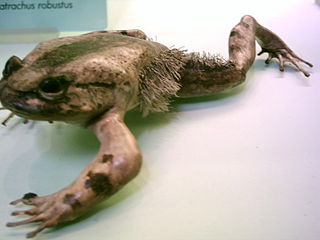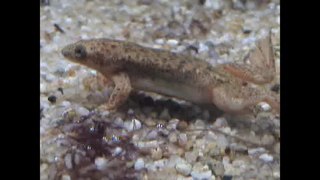
The African clawed frog is a species of African aquatic frog of the family Pipidae. Its name is derived from the three short claws on each hind foot, which it uses to tear apart its food. The word Xenopus means "strange foot" and laevis means "smooth".

A claw is a curved, pointed appendage, found at the end of a toe or finger in most amniotes.

Golden moles are small insectivorous burrowing mammals endemic to Southern Africa, where their Afrikaans names are gouemolle or kruipmolle. They comprise the family Chrysochloridae and as such they are taxonomically distinct from the true moles, family Talpidae, and other mole-like families, all of which, to various degrees, they resemble as a result of evolutionary convergence.

"The Celebrated Jumping Frog of Calaveras County" is an 1865 short story by Mark Twain. It was his first great success as a writer and brought him national attention. The story has also been published as "Jim Smiley and His Jumping Frog" and "The Notorious Jumping Frog of Calaveras County". In it, the narrator retells a story he heard from a bartender, Simon Wheeler, at the Angels Hotel in Angels Camp, California, about the gambler Jim Smiley. The narrator describes him: "If he even seen a straddle bug start to go anywheres, he would bet you how long it would take him to get to wherever he going to, and if you took him up, he would foller that straddle bug to Mexico but what he would find out where he was bound for and how long he was on the road."

The Pipidae are a family of primitive, tongueless frogs. The 41 species in the family Pipidae are found in tropical South America and sub-Saharan Africa.

Rana is a genus of frogs commonly known as the Holarctic true frogs, pond frogs or brown frogs. Members of this genus are found through much of Eurasia and western North America. Many other genera were formerly included here. These true frogs are usually largish species characterized by their slim waists and wrinkled skin; many have thin ridges running along their backs, but they generally lack "warts" as in typical toads. They are excellent jumpers due to their long, slender legs. The typical webbing found on their hind feet allows for easy movement through water. Coloration is mostly greens and browns above, with darker and yellowish spots.

The Mantellidae are a family of the order Anura. These frogs are endemic to the islands of Madagascar and Mayotte.

Xerini is a tribe of ground squirrels occurring in Africa and Asia. With the tribes Marmotini and Protoxerini, they form the subfamily Xerinae. There are three living genera—Xerus, the African ground squirrels; Atlantoxerus, containing the living Barbary ground squirrel of North Africa and some extinct species; and Spermophilopsis, containing the long-clawed ground squirrel of Central Asia.

The African dwarf frog is a type of aquatic frog native to parts of Equatorial Africa. It is common in the pet trade and is often mistaken for the African clawed frog, a similar-looking frog in the same family. African dwarf frogs (Hymenochirus) are also known as dwarf clawed frogs. Their common name is obtained from their place of origin and the claws on their front legs.

Eleutherodactylus is a genus of frogs in the family Eleutherodactylidae. Many of the 200 species of the genus are commonly known as "rain frogs" or "robber frogs", due to their sharp, high-pitched, insect-like calls.

Fejervarya is a genera of frogs in the family Dicroglossidae found in Asia. First proposed in 1915 by István József Bolkay, a Hungarian naturalist, the genus did not see widespread adoption at first. As late as the 1990s it was generally included in Rana, but more recent studies have confirmed its distinctness.

The genus Megachile is a cosmopolitan group of solitary bees, often called leafcutter bees or leafcutting bees; it also includes the called resin bees and mortar bees. While other genera within the family Megachilidae may chew leaves or petals into fragments to build their nests, certain species within Megachile neatly cut pieces of leaves or petals, hence their common name. This is one of the largest genera of bees, with more than 1500 species in over 50 subgenera. The introduced alfalfa leafcutter bee is managed for crop pollination in various regions around the world.

Lithobates is a genus of true frogs, of the family Ranidae. The name is derived from litho- (stone) and the Greek bates, meaning one that treads on rock, or rock climber.

The hairy frog is also known as the horror frog or Wolverine frog. It is a Central African species of frog in the family Arthroleptidae. It is monotypic within the genus Trichobatrachus. Its common name refers to the somewhat hair-like structures on the body and thighs of the breeding male.

Merlin's dwarf gray frog, or Merlin's clawed frog, is a species of frog in the family Pipidae. It is monotypic within the genus Pseudhymenochirus. It is found in southern Guinea-Bissau, western Guinea, and southern Sierra Leone.

The Cameroon clawed frog is a species of frog in the family Pipidae found in Angola, Cameroon, the Central African Republic, the Republic of the Congo, the Democratic Republic of the Congo, Equatorial Guinea, Gabon, and possibly Sudan. Its natural habitats are subtropical or tropical moist lowland forests, freshwater marshes, intermittent freshwater marshes, heavily degraded former forest, and ponds. It is threatened by habitat loss.

The western clawed frog is a species of frog in the family Pipidae, also known as tropical clawed frog. It is the only species in the genus Xenopus to have a diploid genome. Its genome has been sequenced, making it a significant model organism for genetics that complements the related species Xenopus laevis, a widely used vertebrate model for developmental biology. X. tropicalis also has a number of advantages over X. laevis in research, such as a much shorter generation time, smaller size, and a larger number of eggs per spawn.
Uca mjoebergi is a species of fiddler crab discovered by and named after the Swedish zoologist Eric Mjöberg (1882–1938), member of a Swedish scientific expedition to Australia in the early 1900s.

Spy Muppets: License to Croak is an action video game, part of The Muppets franchise and released in 2003 made for Microsoft Windows and Game Boy Advance by Vicarious Visions and distributed by TDK. It is a spoof of the James Bond films, the title being a reference to Licence to Kill. The player controls Kermit the Frog through several stages in order to stop the bad guys.


















